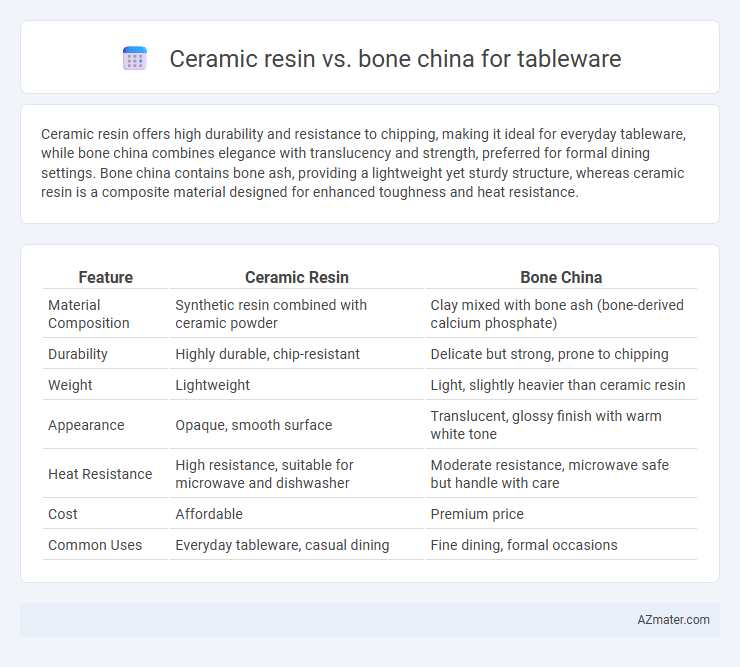Ceramic resin offers high durability and resistance to chipping, making it ideal for everyday tableware, while bone china combines elegance with translucency and strength, preferred for formal dining settings. Bone china contains bone ash, providing a lightweight yet sturdy structure, whereas ceramic resin is a composite material designed for enhanced toughness and heat resistance.
Table of Comparison
| Feature | Ceramic Resin | Bone China |
|---|---|---|
| Material Composition | Synthetic resin combined with ceramic powder | Clay mixed with bone ash (bone-derived calcium phosphate) |
| Durability | Highly durable, chip-resistant | Delicate but strong, prone to chipping |
| Weight | Lightweight | Light, slightly heavier than ceramic resin |
| Appearance | Opaque, smooth surface | Translucent, glossy finish with warm white tone |
| Heat Resistance | High resistance, suitable for microwave and dishwasher | Moderate resistance, microwave safe but handle with care |
| Cost | Affordable | Premium price |
| Common Uses | Everyday tableware, casual dining | Fine dining, formal occasions |
Introduction to Ceramic Resin and Bone China
Ceramic resin is a durable composite material combining ceramic particles with resin binders, offering lightweight and break-resistant tableware ideal for everyday use. Bone china, a type of porcelain containing bone ash, is known for its translucency, high strength, and classic elegance favored in formal dining settings. Both materials provide unique advantages in tableware, balancing aesthetics, durability, and functionality.
Material Composition and Manufacturing Processes
Ceramic resin tableware is composed of synthetic resin combined with ceramic particles, offering enhanced durability and improved resistance to chipping compared to traditional materials. Bone china contains bone ash, feldspar, and kaolin, resulting in a translucent, lightweight yet strong porcelain. Manufacturing ceramic resin involves molding and curing synthetic compounds, while bone china requires precise firing at high temperatures to achieve its characteristic white, vitrified finish.
Durability and Strength Comparison
Ceramic resin tableware offers impressive durability due to its dense composition and resistance to chipping, making it suitable for frequent use in busy settings. Bone china is renowned for its exceptional strength and lightweight nature, attributed to the high bone ash content that enhances its resilience while maintaining a delicate appearance. When comparing durability, bone china tends to be more resistant to breakage under impact, whereas ceramic resin excels in scratch resistance and toughness over long-term use.
Aesthetic Appeal and Design Versatility
Ceramic resin offers a contemporary aesthetic with smooth finishes and vibrant color options, making it ideal for modern tableware designs that emphasize bold and artistic expressions. Bone china, renowned for its delicate translucency and classic elegance, provides a timeless, refined appearance favored in formal dining settings. The design versatility of ceramic resin accommodates innovative shapes and textures, while bone china's traditional craftsmanship supports intricate patterns and subtle detailing that enhance its luxurious appeal.
Weight and Handling Differences
Ceramic resin tableware is generally lighter than bone china, making it easier to handle and less prone to accidental drops during daily use. Bone china, while slightly heavier due to its composition of bone ash, offers greater durability and resistance to chipping, providing a sturdier feel when held. The weight difference impacts user experience, with ceramic resin favored for casual settings and bone china preferred for formal dining due to its luxurious heft and resilience.
Heat and Chip Resistance
Ceramic resin offers superior heat resistance compared to bone china, making it ideal for serving hot dishes without risk of cracking. Bone china, while elegant and lightweight, is more prone to chipping under impact or thermal shock. Choosing ceramic resin ensures enhanced durability and longevity in everyday tableware use, especially in high-temperature scenarios.
Maintenance and Cleaning Requirements
Ceramic resin tableware offers high durability and resists staining, requiring simple handwashing or dishwasher use without special care. Bone china, while elegant and lightweight, demands gentle handling and typically requires handwashing with mild detergents to prevent chipping and preserve its translucent finish. Both materials benefit from avoiding abrasive cleaners, but ceramic resin stands out for lower maintenance needs and greater resistance to everyday wear.
Safety and Food Compatibility
Ceramic resin tableware offers excellent chemical stability and resistance to leaching, making it safe for everyday use, including microwave and dishwasher applications. Bone china contains bone ash, providing high translucency and strength, while being non-porous and resistant to bacterial absorption, ensuring food safety. Both materials meet FDA standards for food contact, but ceramic resin may have a slight advantage due to its synthetic composition, reducing the risk of heavy metal contamination.
Cost and Value for Money
Ceramic resin tableware offers a cost-effective option with durable, lightweight properties suitable for everyday use, often priced lower than bone china. Bone china commands a higher price due to its fine quality, translucency, and elegance, providing superior value for formal settings and long-term collection. Evaluating cost against durability and aesthetic appeal helps determine the best value for money based on intended use and budget constraints.
Popular Use Cases and Consumer Preferences
Ceramic resin tableware is popular for its durability and resistance to chipping, making it ideal for everyday use in casual dining settings and busy households. Bone china is favored for formal occasions and upscale dining due to its lightweight, translucent quality and elegant appearance. Consumers often prefer ceramic resin for practicality and affordability, while bone china attracts those seeking sophistication and refined aesthetics in their tableware.

Infographic: Ceramic resin vs Bone china for Tableware
 azmater.com
azmater.com